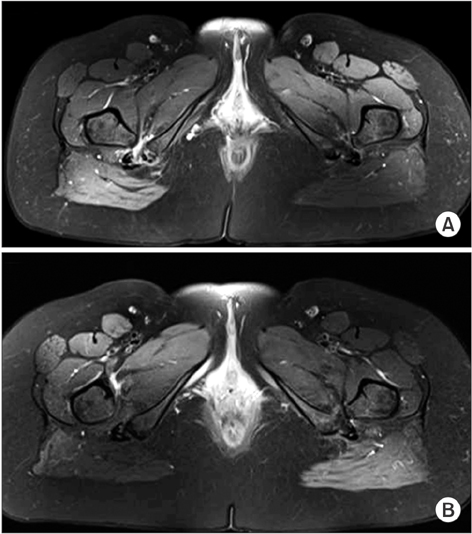Clin Orthop Surg.
2017 Dec;9(4):529-533. 10.4055/cios.2017.9.4.529.
Ischiofemoral Impingement Syndrome: Outcomes of Endoscopic Resection of the Lesser Trochanter
- Affiliations
-
- 1Department of Orthopedic Surgery, University Hospital of Vall d'Hebron, Barcelona, Spain. j.nuñez@vhebron.net
- KMID: 2412255
- DOI: http://doi.org/10.4055/cios.2017.9.4.529
Abstract
- Ischiofemoral impingement syndrome is a rare clinical entity characterized by chronic groin, buttock or hip pain associated with radiographic evidence of narrowing of the space between the lesser femoral trochanter and the ischial tuberosity. Introduction of magnetic resonance imaging to the clinical practice as well as the establishment of the radiological definition of the abnormal ischiofemoral distance has led to an increasing interest in this condition. Ischiofemoral impingement syndrome is a poorly understood disorder of chronic pain, especially regarding its treatment. The authors present two cases of primary ischiofemoral impingement syndrome successfully treated with a minimally invasive surgical technique. With this endoscopic technique, it was possible to resect the lesser trochanter and restore the ischiofemoral space. Immediate clinical and functional improvement was reported by both patients.
MeSH Terms
Figure
Reference
-
1. Stafford GH, Villar RN. Ischiofemoral impingement. J Bone Joint Surg Br. 2011; 93(10):1300–1302.
Article2. Tosun O, Algin O, Yalcin N, Cay N, Ocakoglu G, Karaoglanoglu M. Ischiofemoral impingement: evaluation with new MRI parameters and assessment of their reliability. Skeletal Radiol. 2012; 41(5):575–587.
Article3. Johnson KA. Impingement of the lesser trochanter on the ischial ramus after total hip arthroplasty: report of three cases. J Bone Joint Surg Am. 1977; 59(2):268–269.
Article4. Taneja AK, Bredella MA, Torriani M. Ischiofemoral impingement. Magn Reson Imaging Clin N Am. 2013; 21(1):65–73.
Article5. Safran M, Ryu J. Ischiofemoral impingement of the hip: a novel approach to treatment. Knee Surg Sports Traumatol Arthrosc. 2014; 22(4):781–785.
Article6. Howse EA, Mannava S, Tamam C, Martin HD, Bredella MA, Stubbs AJ. Ischiofemoral space decompression through posterolateral approach: cutting block technique. Arthrosc Tech. 2014; 3(6):e661–e665.
Article7. Hatem MA, Palmer IJ, Martin HD. Diagnosis and 2-year outcomes of endoscopic treatment for ischiofemoral impingement. Arthroscopy. 2015; 31(2):239–246.
Article8. Jo S, O'Donnell JM. Endoscopic lesser trochanter resection for treatment of ischiofemoral impingement. J Hip Preserv Surg. 2015; 2(2):184–189.
Article9. Wilson MD, Keene JS. Treatment of ischiofemoral impingement: results of diagnostic injections and arthroscopic resection of the lesser trochanter. J Hip Preserv Surg. 2016; 3(2):146–153.
Article10. Ilizaliturri VM Jr, Camacho-Galindo J. Endoscopic treatment of snapping hips, iliotibial band, and iliopsoas tendon. Sports Med Arthrosc. 2010; 18(2):120–127.
Article
- Full Text Links
- Actions
-
Cited
- CITED
-
- Close
- Share
- Similar articles
-
- Stress Fracture after Arthroscopic Lesser Trochanter Resection: Diagnosis and Therapy
- Ischiofemoral Impingement Syndrome
- A Case of Ischiofemoral Impingement Syndrome as a Differential Diagnosis of Ankylosing Spondylitis
- New Wiring Method for Lesser Trochanter Fixation in Unstable Intertrochanteric Fractures: Technical Note
- Utility of False Profile View for Screening of Ischiofemoral Impingement




